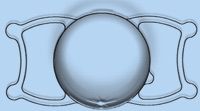Article
Prospective study finds accommodative IOL performs well
Chicago—A prospective study including consecutive eyes implanted with the KH-3500 IOL (Kellan TetraFlex, Lenstec) showed that pseudophakic implant is associated with encouraging results in measurements of subjective accommodation although its objective accommodating effect appears to be limited, reported Sunil Shah, MD, at the annual meeting of the American Academy of Ophthalmology.
Chicago-A prospective study including consecutive eyes implanted with the KH-3500 IOL (Kellan TetraFlex, Lenstec) showed that pseudophakic implant is associated with encouraging results in measurements of subjective accommodation although its objective accommodating effect appears to be limited, reported Sunil Shah, MD, at the annual meeting of the American Academy of Ophthalmology.

Subjective amplitude of accommodation was evaluated with the RAF rule and found to average 3.1 D at 1 month with a wide range from 1.0 to 6.4 D. By 6 months the average amplitude of accommodation decreased to 1.7 D, but the range remained fairly similar.
"We must consider that the objective measures obtained with the Shin Nippon machine are limited to global measures across the whole pupillary area. Early work with the Tracey aberrometer does seem to confirm focal changes in power within the pupillary area of up to 6 D, which is far more in keeping with the subjective data," Dr. Shah said. "We have not encountered any downsides with this lens. Implantation has been simple, even for our residents, and the surgery has not been associated with any complications. Postoperatively, there have not been problems with glare or halos, and overall, the lens seems to be working well for these patients and they are very happy."

Using the Shin Nippon SRW-5000, Dr. Shah and coworkers also investigated the dynamic amplitude of eyes implanted with the KH-3500 IOL. Those studies showed an average objective dynamic accommodation of 0.71 D (range, 0.31 to 1.56 D) and a lag time behind the target of 0.50 seconds.
"That lag time is longer than with a normal phakic eye and perhaps we will need to tell recipients of the KH-3500 lens to expect it will take a little time when they are trying to achieve accommodation," Dr. Shah said.
Additional analyses showed that accommodative amplitude was correlated to pupil size but not to IOL power.
"The relationship between accommodative amplitude and pupil size was what we would expect, but the lack of correlation with IOL power was a little surprising if we are expecting these lenses to achieve accommodation by axial movement," Dr. Shah said.
Refractive outcomes
Refractive outcomes with the KH-3500 lens have been excellent. With use of the manufacturer-provided A constant, mean spherical refraction was 0.23 D and mean cylinder was –0.83 D at 6 months postoperatively. Mean logMAR best-corrected visual acuity at that visit was 0.06 at distance and 0.58 at near.





.png&w=3840&q=75)















